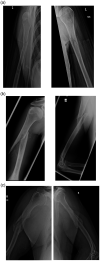A comparative study of 6-week and 12-week Radiographic Union Scores for HUmeral fractures (RUSHU) as a predictor of humeral shaft non-union
- PMID: 35599708
- PMCID: PMC9121295
- DOI: 10.1177/17585732211033154
A comparative study of 6-week and 12-week Radiographic Union Scores for HUmeral fractures (RUSHU) as a predictor of humeral shaft non-union
Abstract
Background: Non-union in non-operatively managed humeral shaft fractures are associated with significant morbidity. Hence, developing a robust system that could help with early diagnosis is important. We aimed to evaluate the validity of the Radiographic Union Score for HUmeral fractures (RUSHU) at 6 weeks (RUSHU-6) and test whether a RUSHU at 12 weeks (RUSHU-12) would be a better predictor of non-union.
Methods: We retrospectively reviewed all non-operatively managed humeral diaphyseal fractures from 2012 to 2018. Statistical analysis was used to determine the cut-off RUSHU-12 and evaluate the effect of RUSHU-6 and RUSHU-12 on non-union prediction.
Results: In sum, 32 patients had radiographs at 6 weeks post-injury, 27 of which also had radiographs at 12 weeks. A RUSHU cut-off of 9 was the best predictor of non-union at 12 weeks. Only RUSHU-12 had a statistically significant influence predicting non-union (P = 0.011) and there was a significant correlation (P = 0.003) between score progression from RUSHU-6 to RUSHU-12 and the development of non-union.
Discussion: A RUSHU-12 of <9 and a low score progression between 6 and 12 weeks suggest superior predictive value in determining the likelihood of non-union. Further validation in the form of a large multicentred study is however required.
Keywords: Humerus; RUSHU; diaphysis; non-operative; non-union.
© 2021 The British Elbow & Shoulder Society.
Conflict of interest statement
Declaration of Conflicting Interests: The author(s) declared no potential conflicts of interest with respect to the research, authorship, and/or publication of this article.
Figures




Similar articles
-
The Radiographic Union Score for HUmeral fractures (RUSHU) predicts humeral shaft nonunion.Bone Joint J. 2019 Oct;101-B(10):1300-1306. doi: 10.1302/0301-620X.101B10.BJJ-2019-0304.R1. Bone Joint J. 2019. PMID: 31564159
-
Predicting the Behavior of Humeral Shaft Fractures: An Independent Validation Study of the Radiographic Union Score for HUmeral Fractures and Value of Assessing Fracture Mobility.J Orthop Trauma. 2021 Oct 1;35(10):555-559. doi: 10.1097/BOT.0000000000002063. J Orthop Trauma. 2021. PMID: 33480643
-
Validation of the Radiographic Union Score for HUmeral fractures (RUSHU): A retrospective study in an independent centre.Shoulder Elbow. 2023 Aug;15(4):390-397. doi: 10.1177/17585732221097092. Epub 2022 May 3. Shoulder Elbow. 2023. PMID: 37538525 Free PMC article.
-
Operative versus non-operative treatment of humeral shaft fractures: A systematic review.Shoulder Elbow. 2020 Aug;12(4):229-242. doi: 10.1177/1758573218825477. Epub 2019 Feb 2. Shoulder Elbow. 2020. PMID: 32788928 Free PMC article. Review.
-
Humeral Fractures Sustained During Arm Wrestling: A Retrospective Cohort Analysis and Review of the Literature.Orthopedics. 2018 Mar 1;41(2):e207-e210. doi: 10.3928/01477447-20180102-05. Epub 2018 Jan 9. Orthopedics. 2018. PMID: 29309719 Review.
Cited by
-
Comment on "A comparative study of 6-week and 12-week Radiographic Union Scores for HUmeral fractures (RUSHU) as a predictor of humeral shaft non-union".Shoulder Elbow. 2022 Apr;14(2):230-231. doi: 10.1177/17585732221076073. Epub 2022 Feb 1. Shoulder Elbow. 2022. PMID: 35265190 Free PMC article. No abstract available.
-
Prediction of humeral shaft fracture healing using the Radiographic Union Score for HUmeral Fractures (RUSHU).Bone Jt Open. 2024 Nov 4;5(11):962-970. doi: 10.1302/2633-1462.511.BJO-2024-0134.R1. Bone Jt Open. 2024. PMID: 39489162 Free PMC article.
-
Effect of individualized narrative nursing mode on recovery of elderly patients with fracture complicated with cerebrovascular accident.Medicine (Baltimore). 2024 Jan 19;103(3):e36901. doi: 10.1097/MD.0000000000036901. Medicine (Baltimore). 2024. PMID: 38241550 Free PMC article.
References
-
- Ekholm R, Adami J, Tidermark J, et al. Fractures of the shaft of the humerus. An epidemiological study of 401 fractures. J Bone Joint Surg Br 2006; 88: 1469–1473. - PubMed
-
- Tytherleigh-Strong G, Walls N, McQueen MM. The epidemiology of humeral shaft fractures. J Bone Joint Surg Br 1998; 80: 249–253. - PubMed
-
- Court-Brown CM, Caesar B. Epidemiology of adult fractures: a review. Injury 2006; 37: 691–697. - PubMed
-
- Koch PP, Gross DFL, Gerber C. The results of functional (Sarmiento) bracing of humeral shaft fractures. J Shoulder Elbow Surg 2002; 11: 143–150. - PubMed
LinkOut - more resources
Full Text Sources
